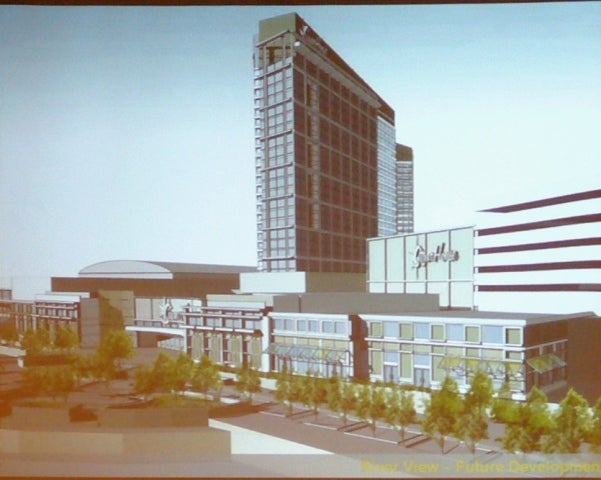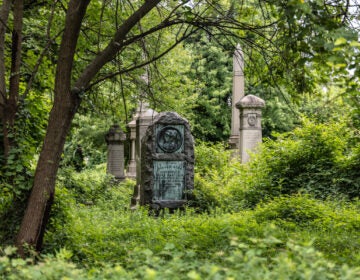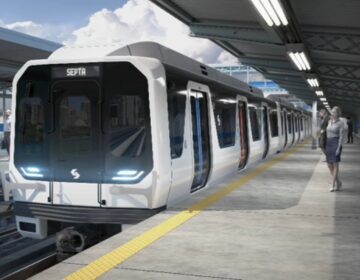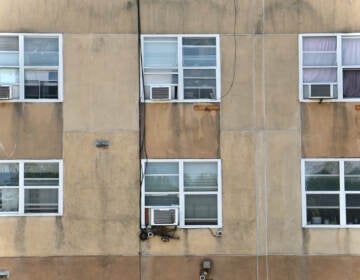SugarHouse passes PCPC muster

May 22
By Matt Blanchard
For PlanPhilly
SugarHouse unveiled its 3.4 million square foot development plan for a casino on Delaware Avenue before the Philadelphia City Planning Commission on Tuesday, and – in another blow to the anti-casino movement – won that commission’s approval.
The three-phase plan envisions the 22-acre site on the Fishtown waterfront as a vast and stylish recreation complex, sprouting two hotel towers with a total of 1,200 rooms, and an array of amenities including a 50-foot-wide public river esplanade.
“This project will be the cornerstone of future development of our waterfront,” said project architect Ian Cope of Cope Linder Architects, who promised a high-quality, contemporary design. “These are anything but windowless boxes,” he said.
Despite more than an hour of public comment – almost all of it vigorously against the casino – the Planning Commission voted 6-0 in support of SugarHouse with very little discussion.
The move means SugarHouse now advances in front of City Council with the Planning Commission’s full endorsement on two matters: its design and development review, and a zoning change to the “Commercial Entertainment District” designation required to proceed.
Ahead, SugarHouse faces a skeptical City Council, including councilman Frank DiCicco, who has lately been fighting hard to keep casinos out of his district. On June 6 council’s rules committee will hear ordinances DiCicco has introduced that would hinder siting and construction of the casinos.
SugarHouse must also secure state permission for the use of riparian (or riverbed) lands, or see their building site reduced by almost one half.
The Debate
Anti-casino activists from Casino Free Philadelphia entered Tuesday’s meeting high from their successful Election Day ballot, in which 12,500 people cast unofficial votes to remove casinos at least 1,500 feet from residential neighborhoods.
But they left angry. Angry that the commission refused to table the matter. Angry that they only gave 24-hours notice of Tuesday’s meeting. And angry that the widespread public opposition to casinos captured in their anti-casino ballot seemed to count for nothing.
“It takes a lot of money to buy corrupt politicians,” said Daniel Hunter, a lead organizer for Casino Free Philadelphia. “That’s all I have to say about it.”
Anti-casino attorney Paul Boni had argued half-a-dozen legal technicalities why the commission’s vote might violate city and state laws: “You can do nothing else but reject what you see before you today,” he told them. City Solicitor Romulo Diaz countered that the commission was well within its legal rights and duties.
Two lawmakers had sent letters in opposition, suggesting the commission’s vote would be premature considering various pending legal matters. Citizens, including two clergy, also spoke against the plan and Ed Goppelt, creator of the popular Hallwatch political news blog, took off his impartial “reporter hat” to make a plea of his own: “I would ask whether it might not be a good idea to table this discussion.” No luck.
Sugarhouse got support from three citizens, including Donna Tomlinson of an organization called Fishtown Action Committee, which she said was organized to support the casino.
“We believe the project will have a positive impact on our community,” Tomlinson said, criticizing Casino Free Philadelphia for misrepresenting the Fishtown mood. “The majority of residents anxiously await this development. We know the jobs at Sugarhouse will offer decent wages, health benefits, and the promise of careers to our young people.”
The Commission’s View
The commission’s reasoning was apparently rooted in the perceived economic benefits of gambling. Each year, casinos would funnel $5 million to Philadelphia School District and an estimated $20 to $25 million into the city’s general fund, allowing a possible 13 percent reduction to the city’s wage tax. During the meeting, commission chair Janice Woodcock repeatedly reminded the audience that “any delay in gaming will throw off the city’s five year fiscal plan.”
In addition, some on the commission said they simply liked the plan. Commissioner Patrick Eiding had originally supported putting the casinos in Center City and believed SugarHouse would enliven the riverfront.
“I happen to think that if you want a city to be alive, you put some lively things in it,” said Eiding, commending the plan for “good walk-off-the-street restaurants,” varied entertainment options and access to public transit.
Eiding, president of Philadelphia Council AFL-CIO, responded sharply to charges that the commission was acting as a rubber stamp for Mayor Street.
“Nobody tells me what to do,” Eiding said. “I don’t need this commission job. It’s an unpaid position.”
Details of the Sugarhouse Design
The site is a 22-acre trapezoid just north of the new Waterfront Square apartment towers, with a northern boundary at Shackamaxon Street. It has 1,400 feet of frontage on Delaware Avenue and a narrower 1,000 feet along the river itself. It’s about one mile north of Penn’s Landing.
If neighbors are wondering what to expect, architect Ian Cope described a project with two major phases, preceded by an “interim casino” set to open in 2008.
The interim casino is to house 1,500 slot machines and will open on the site in 2008. Cope said it was not a “temporary” structure, but rather an early part of the main structure rushed into production to meet a state deadline for revenue generation.
Phase One of the project occupies the northern half of the site and is slated to open in 2009. Along Delaware Avenue, the plan calls for a food court and off-track betting facility right up against the sidewalk, to create a more urban streetscape, except for a semi-circular landscaped drive that leads to a porte-cochere at the main entrance. Inside, visitors encounter a 3,000-machine slot parlor at the center of the site.
Along the river, Sugarhouse is promising a 50-70 foot public promenade, with a fan-shaped public park 300 feet in length bowing out into the river. Riverfront restaurants will overlook the promenade on terraces.
Phase One includes a self-park garage for 4,200 cars, free to casino patrons.
Cope said the style of the buildings will “project a contemporary character, rather than some sort of arbitrary theme or historic character.” Building materials on the main casino building will include architectural aluminum panels, colored glass and natural stone.
Phase Two expands to the south, adding one or possibly two hotel towers of at least 300 feet in height, with a possible 1,200 hotel rooms. It also adds a 30,000 square foot entertainment venue for live music or social gatherings. Plans also call for a second parking structure, three or four more restaurants, and a strip of retail shops along Delaware Avenue.
“The entire Delaware Avenue frontage is active, with service and parking areas shielded well within the site,” Cope said, “We believe this is a balanced composition, with a scale and massing that are appropriate.”
WHYY is your source for fact-based, in-depth journalism and information. As a nonprofit organization, we rely on financial support from readers like you. Please give today.






